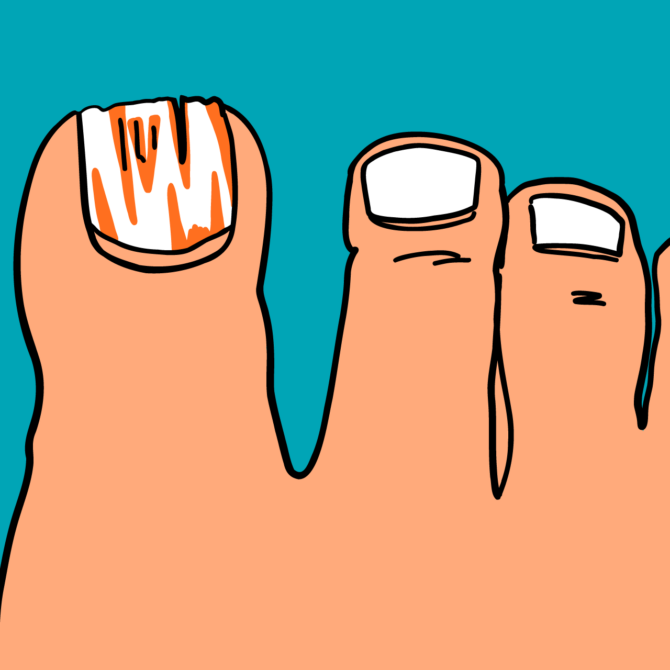What treatments are available for fungal toenails?
Five main treatments are available for fungal toenails:
- Topical antifungal treatments
- Medicated nail creams
- Oral antifungal medications
- Laser and light-based therapies
- Surgery to remove the fungal toenails
This section discusses these treatments in detail. First, though, you should make sure that your toenail problem is indeed fungal toenails.
1a) Getting your condition diagnosed
Normally, the best way to start is by going to your doctor for a definitive diagnosis rather than trying to treat the problem with over-the-counter medications. Assuming that the diagnosis is indeed fungal toenails, the doctor will likely prescribe a prescription-strength topical antifungal agent, which is discussed next.
1b) Topical antifungal agents
The first line of attack on fungal toenails is topical antifungal agents. Some antifungal agents are available over the counter, but the heavier-duty antifungal agents are prescription medicines. If you have a mild case of fungal toenails, an over-the-counter antifungal agent may be enough to clear it up. Generally, however, you are better off using a prescription-strength antifungal agent to get rid of the infection without giving it time to take root. Getting rid of a fungal toenail can take a year or more, so it is best to start immediately.
Of these prescription antifungal agents, the most widely used is ciclopirox, which comes as a lacquer that you apply to your fungal toenails and the surrounding skin once a day. You will typically need to file down the nails, removing loose parts and rough surfaces to enable the lacquer to penetrate farther into the nail and the nail bed. Another lacquer-style treatment is amorolfine, which you apply once or twice a week to your affected toenails. Two newer daily treatments are tavaborole and efinaconazole. With efinaconazole, you do not need to file down your toenails.
2) Medicated nail creams
Medicated nail creams are another means of tackling fungal toenails. These creams usually contain one of four antifungal agents — ciclopirox, terbinafine, clotrimazole, or ketoconazole — and are applied to the skin around the nails and to the nails themselves. Medicated nail creams may not be effective enough to clear up deep-seated fungal infections on their own. Doctors sometimes prescribe them alongside oral antifungal medications, discussed next.
3) Oral antifungal medications
If topical antifungal medications do not clear up your fungal toenails, or do not clear up the infection completely, the next means of treatment is oral antifungal medications. These have a systemic effect — working on your entire body, not just topically on the toenails — and are typically effective for clearing up severe or extensive fungal infections. The disadvantage is that oral antifungal medications can have unpleasant side effects.
These are the three oral antifungal medications most widely used for fungal toenails:
- Terbinafine. A course of treatment for fungal toenails typically lasts 12 weeks. The side effects can include gastrointestinal upsets, headache, rash, and (rarely) liver problems.
- Itraconazole. A course of treatment for fungal toenails lasts about 12 weeks, but the treatment may be pulsed (delivered on and off) rather than continuous. Side effects may include rash, nausea, and liver enzyme elevations.
- Fluconazole. A course of treatment for fungal toenails typically lasts several months. Side effects may include nausea, abdominal pain, and liver problems.
4) Laser and light treatments
Other means of treating fungal toenails include laser treatment and photodynamic therapy (PDT):
- Laser treatment: The practitioner uses a laser, such as an Nd:YAG laser, to heat the toenail and the fungus, trying to stop the fungus from spreading. The treatment normally requires multiple sessions a few weeks apart. The treatment appears to work in some people, but further research is needed to determine the best way to treat fungal toenails with lasers.
- Photodynamic therapy (PDT): The practitioner applies a photosensitising agent — such as 5-aminolevulinic acid (5-ALA) or methyl aminolevulinate (MAL) — to the nail, and then activates it using a specific wavelength of light. This treatment usually requires multiple sessions, and its success rate and long-term effects are still being determined.
5) Surgical removal of the toenail
The last resort for dealing with fungal toenails is to remove the affected toenails surgically. This operation is called avulsion or nail excision and is performed under local anaesthetic. Depending on the severity of the infection, either the whole toenail or just part of it is removed, exposing the underlying nail bed. The nail bed is then usually treated with a topical antifungal agent to reduce the risk of reinfection. After the operation, the nail grows back. But, it is important to note that this takes several months, and there is a risk that the nail may become ingrown or grow back crooked.





 The Tweakments Chatbot
The Tweakments Chatbot